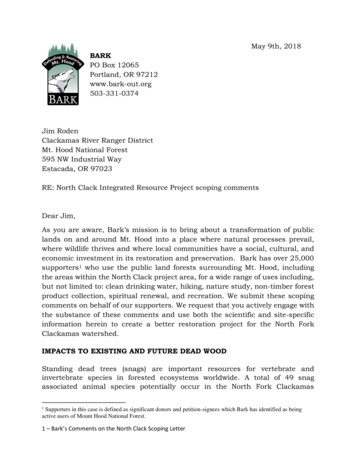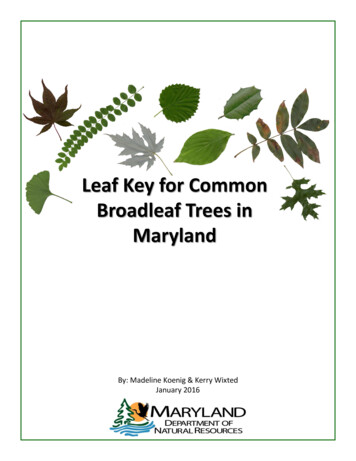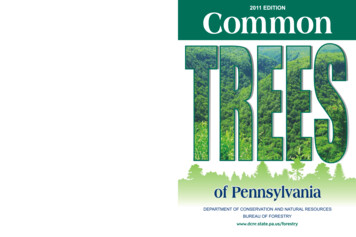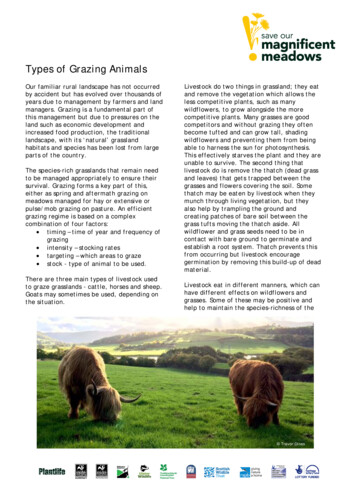
Transcription
May 9th, 2018BARKPO Box 12065Portland, OR 97212www.bark-out.org503-331-0374Jim RodenClackamas River Ranger DistrictMt. Hood National Forest595 NW Industrial WayEstacada, OR 97023RE: North Clack Integrated Resource Project scoping commentsDear Jim,As you are aware, Bark’s mission is to bring about a transformation of publiclands on and around Mt. Hood into a place where natural processes prevail,where wildlife thrives and where local communities have a social, cultural, andeconomic investment in its restoration and preservation. Bark has over 25,000supporters1 who use the public land forests surrounding Mt. Hood, includingthe areas within the North Clack project area, for a wide range of uses including,but not limited to: clean drinking water, hiking, nature study, non-timber forestproduct collection, spiritual renewal, and recreation. We submit these scopingcomments on behalf of our supporters. We request that you actively engage withthe substance of these comments and use both the scientific and site-specificinformation herein to create a better restoration project for the North ForkClackamas watershed.IMPACTS TO EXISTING AND FUTURE DEAD WOODStanding dead trees (snags) are important resources for vertebrate andinvertebrate species in forested ecosystems worldwide. A total of 49 snagassociated animal species potentially occur in the North Fork Clackamas1Supporters in this case is defined as significant donors and petition-signees which Bark has identified as beingactive users of Mount Hood National Forest.1 – Bark’s Comments on the North Clack Scoping Letter
watershed alone. In the Douglas-fir and western hemlock forests of the PacificNorthwest, over 100 vertebrate species utilize snags for some part of their lifecycle. Approximately 20 percent of all bird species in the Pacific Northwestdepend on snags for nesting and feeding and the abundance of snag-dependentbirds is correlated with the density of suitable snags2. Studies show that, “cavityusers typically represent 25 to 30% of the terrestrial vertebrate fauna in theforests of the Pacific Northwest.”3. This study goes on to note that a “lack of cavitysites is the most frequently reported threat to “at-risk” species in the PacificNorthwest.”The FS has in the past asserted that thinning improves residual tree health andthat it may take longer for the residual trees to die (reducing snag density) in theProposed Action scenarios compared with No Action. Research has also shownthat thinning lowers snag density relative to un-harvested stands.4 Interestingly,while the agency recognizes that timber harvest has undisputed negative effectson snag density, it often claims that thinning will produce more structuraldiversity in the future. These claims do not present a complete understandingof ecological processes regarding future snag recruitment, especially in neverlogged forests.Until recently, few studies have examined the effects of variable density thinning(VDT) at longer time scales. A study of 14-year growth response of residual treesin thinned and un-thinned VDT sub-treatments in five young mixed-coniferstands located on the Olympic Peninsula in western Washington revealed thatthinning was ineffective at stimulating growth of upper canopy trees. In this sizeclass neither diameter growth nor crown length increased significantly comparedto trees in un-thinned patches.5 This research does not provide support the FS’scommon claim that thinning will accelerate growth of residual trees, leading tolarger snags in the distant future. Please read this report and incorporate itsfindings into the PA for North Clack.Thinning of maturing forest has been shown to significantly delay attainment ofMt. Hood National Forest (MHNF)’s snag objectives.6 The LRMP requires that2Boleyn, P., Wold, E., and Byford, K., Created Snag Monitoring on the Willamette National Forest, USDA ForestService Gen. Tech. Rep. PSW-GTR-181. 20023Bunnell, F.L., Kremsater, L.L., and Wind, E. 1999. Managing to sustain vertebrate richness in forests of the PacificNorthwest: relationships within stands. Environmental Review, 7: 97-146.4Windom, M. and Bates, L. 2008. Snag density varies with intensity of timber harvest and human access. ForestEcology and Management 255(7) pp. 2085-2093.5Willis, John L.; Roberts, Scott D.; Harrington, Constance A. 2018. Variable density thinning promotes variablestructural responses 14 years after treatment in the Pacific Northwest. Forest Ecology and Management. 410: 114125. https://doi.org/10.1016/j.foreco.2018.01.006.6USDA Forest Service. 2007. Curran Junetta Thin Environmental Assessment. Cottage Grove Ranger District,Umpqua National Forest. June 2007. Using data from stand exams modeled through FVS-FFE (West Cascades2 – Bark’s Comments on the North Clack Scoping Letter
dead wood be maintained to support 60% of maximum biological potential ofcavity nesting species (FW-215). According to the FS, this standard often cannotbe met because of the purpose and need for the project (FW-32/33) and the onthe-ground conditions present within the stands (FW-215/219). In that case, theLRMP requires that any new timber harvest project include wildlife treeprescriptions to compensate for the deficiency (FW-217).Commercial thinning may prevent or delay development of essential features ofold forest ecosystems, features important to spotted owls, salmon, and theirprey. In 2016, the FS and the Bureau of Land Management (BLM) released anannotated bibliography compiling studies that examined the impacts of thinningin mature forest stands7 which was recently reviewed by Paul Reed, a PhDstudent at the University of Oregon.8 Overall, the bibliography addressed avariety of characteristics of old-growth forest structure. While there is someevidence that thinning could positively affect aspects of late-successionaldevelopment, significant and consistent evidence of this type is generally lacking.This is especially true regarding the mid & long-term impacts of thinning on theabundance and size of snags and downed wood. These old-growth structuralfeatures are largely overlooked though available data suggests that thinning doesnot do an adequate job managing for these features. According to Reed, becauseof the lack of compelling evidence, it is appropriate to implement a precautionaryapproach towards managing and thinning mature forest stands.Large snags (as well as dense forest surrounding them) are critical habitatrequirements of Westside indicator species like flying squirrels and spottedowls9, and are currently in short supply due to past and present management.According to the North Fork Clackamas Watershed Analysis, due to pastmanagement there has been a lack of snags leading to a “snag lag” (for largesnags specifically) which could continue until approximately 2026.In response to the significant loss of large and old trees, the Interior ColumbiaBasin Ecosystem Management Project SDEIS included the following statementin its standards and objectives, which although written for the Eastside, isrelevant to Westside forests with limited large snags:Maintain and/or restore large shade-intolerant trees and snags in densities thatare consistent with the range of historical conditions. Large trees is a relativeterm dependent on species and site. Large trees are a future source of large snags,variant) the Umpqua NF found that the actual effect of heavy thinning is to capture mortality and delay recruitmentof desired levels of large snag habitat for 60 years or more.7Powers, M., and S. Wessell. 2016. Management impacts and developmental patterns in mature Douglas-fir forestsof the Pacific Northwest: An Annotated Bibliography.8Reed, P. 2016. Reviewing the US Forest Service and Bureau of Land Management’s “mature stand thinning”bibliography.3 – Bark’s Comments on the North Clack Scoping Letter
and large snags are a future source of coarse woody debris, another importanthabitat component for many species. It is important to have present and futuresources of large trees and snags at adequate levels though time. Larger snags aregenerally better than smaller snags because they exist longer. Large trees and/orsnags are essential habitat components for many species 10Because snags that are artificially created (through girdling) take years to provideany potential habitat (and the quality of this artificial habitat is uncertain), theNorth Clack project could easily result in an immediate net reduction of snagsacross the landscape and contribute to the larger issue of a regional snag deficitresulting from previous Forest Service (FS) management. Since large snags arerequired for the habitat requirements of Westside indicator species like flyingsquirrels and spotted owls11, but are in short supply due to past and presentmanagement, the FS should exclude stands with high snag and large livingtree densities from any logging and apply buffers on key snags andrelatively large trees within proposed units.In short, the significant role played by large snags in the healthy functioning ofthe forest ecosystem is well documented. Recently, both the role of logging onthe numbers of large snags and the ineffectiveness of current artificial snagcreation has been documented. The impact of logging on large snag density12clearly shows that the paucity of large snags across a managed forest landscaperelates to the logging of that landscape. Further, the usefulness of artificiallycreated snags has been thrown into doubt.13 Knowing that this project has astrong likelihood of adversely impacting legacy forest features, which in turn willhave a significant impact of the healthy functioning of the remaining forestecosystem, directly contradicts the assertion that the project will enhancebiological diversity. This must be acknowledged and accounted for in the PA.THINNING IN LATE SUCCESSIONAL RESERVESThe North Clack project includes 191 acres of “variable-density thinning withskips and gaps” in Late-Successional Reserves (LSRs). According to theNorthwest Forest Plan (NWFP), LSRs are to be managed to protect and enhanceconditions of late-successional and old-growth forest ecosystems, which serve ashabitat for late-successional and old-growth reacted species, including theUSDA/USDI 2000. ICBEMP SDEIS p 3-66 – 3-68.Cline, S.P., Berg, A.B., Wight, H.M., 1980. Snag characteristics and dynamics in Douglas-fir Forests, WesternOregon. Journal of Wildlife Management 44, 773–786.12Issue 42 (March 2002) Dead wood all around us: think regionally to manage locally, by Janet Ohmann and KarenWaddell13USDA Forest Service Gen. Tech. Rep. PSW-GTR-181. 200210114 – Bark’s Comments on the North Clack Scoping Letter
northern spotted owl. NWFP Standards & Guidelines, C-11. Thinning and othersilvicultural treatments inside reserves are subject to review by the RegionalEcosystem Office to ensure that the treatments are beneficial to the creation oflate-successional forest conditions. NWFP Standards & Guidelines, C-13.The purpose of any silvicultural treatment within a LSR must be to benefit thecreation and maintenance of these late-successional forest conditions. NWFP atC-12. As there is a general prohibition on commercial logging in LSRs, it is theburden of the agency to show that the proposed actions are clearly needed andwill not prevent the LSR from providing the habitat for which it was created. Inthe PA, please provide specific stand information for units proposed forlogging within LSRs, and rationale for the actions proposed within thesestands, beyond simply growing bigger trees faster. In particular, pleasediscuss the role of standing and down dead trees in enhancing biodiversity andthe ecological impact of decreasing future snag retention by logging in LSRs. Ifyour rationale is incomplete or inconsistent with the projected outcomes ofcommercial thinning (in relation to expediting the creation of late-successionalstructure), Bark recommends dropping these units from consideration.IMPACTS TO NORTHERN SPOTTED OWL HABITATThe North Clack project area contains one historic northern spotted owl nestsite. According to the FS, the ‘thin-owl emphasis’ units are commercial thinningtreatments with the objective to move the stands towards suitable habitat on afaster trajectory. They would include a light variable density thinning from belowthat will include skips and gaps and a post treatment canopy cover of 60-70%,with all large legacy trees being retained. Bark will be field-checking these unitsand then provide input on the accomplishment of achieving suitable habitatthrough this lighter-than-normal technique of thinning.Suitable spotted owl habitat stands are characterized as having large diametertrees, high amounts of canopy cover, and decadence components such asbroken-topped live trees, mistletoe, cavities, large snags, and fallen trees. If theFS wishes to recover spotted owl habitat, it must allow no degrading orremoval of this habitat from the North Fork Clackamas watershed as partof the North Clack project.Further, within units in the historic home range of the spotted owl, werecommend: Retaining an average canopy cover of at least 40% to maintain dispersalowl habitat5 – Bark’s Comments on the North Clack Scoping Letter
Limiting gaps to 1/4 acre in size with less than 10% of the total stand areain gapsProhibiting cutting of trees larger than 20 inches in diameter (at a heightof 4.5 feet) unless necessary for skyline corridors, skid trails, landings ortemporary roads, in which case these trees are to be left on site as downedwood.Removing Riparian Reserve logging from consideration.According to the North Fork Clackamas Watershed Analysis, Riparian Reservesin this area are especially important to support creation and retention of suitablehabitat characteristics, as they are some of the first stands to become suitablehabitat in the future. WA at 2-55. “Over the long term, late seral habitat in theNorth Fork watershed would be found primarily in the Riparian Reserves, whichcomprise 32% of federal land in the watershed.” WA at 1-16. The North Fork’srole in the NWFP’s connectivity strategy is within the RRs, as well as small lateseral blocks. However, the North Clack project includes 947 acres of “variabledensity thinning with skips and gaps” in Riparian Reserves. Along with our otherconcerns about thinning in Riparian Reserves (elaborated below) this specificallyconcerns us. Please provide rationale for why the FS believes thinning inRiparian Reserves within the historic home range is consistent withpromoting future suitable habitat for northern spotted owls.Impacts to northern flying squirrelsIn past comments, Bark expressed concern about impacts to northern flyingsquirrels (a principle spotted-owl prey), and we bring this concern up again here.The owl recovery plan recommends active management in critical habitat toimprove conditions for the long term (USDI 2011 at III-19). According to agencyresearch, variable-density thinning of Douglas fir stands can reduce thesuitability of the site for the northern flying squirrels for 30 to 100 years, untillong-term ecological processes (often also suppressed by thinning) providesufficient structural complexity in the mid-story and over-story favorable tosquirrels. Northern flying squirrel populations in mature and second growthforests decline after the stands are thinned and remain at low levels. Researchhas found that squirrel populations in un-thinned patches are larger than inthinned, and even those decline when adjacent areas are thinned.14 Predationseems to be the most limiting factor – thinning opens the stands and results ina period of several decades when squirrels are too vulnerable to predation, so the14Wilson, T.M. 2010. Limiting factors for northern flying squirrels (Glaucomys sabrinus) in the PacificNorthwest: a spatio-temporal analysis. Ph.D. dissertation. Cincinnati, OH: Union Institute & University.6 – Bark’s Comments on the North Clack Scoping Letter
population remains very low. Prescriptions that retain visual occlusion in themid-story layers are best suited for maintaining squirrel populations.Since recommendations for managing forests include retaining some areas ofhigh stem density, retaining the mid-story, and retaining a contiguous closedcanopy, Bark has expressed concern about the impact of thinning, especially infire-origin stands, on retaining these key features. A strategy of maintainingadequate area and connectivity of dense, closed-canopy forests within managedlandscapes by leaving areas of young forest un-thinned has been recommendedby researchers to maintain northern flying squirrel populations15.In a 2013 paper by Todd M. Wilson and Eric D. Forsman, the ManagementConsiderations includes the idea that: “It may be possible to develop newthinning prescriptions that keep moderately highpopulations of arborealrodents in young forests while still achieving long-term management objectivesfor the stand.” We have suggested one such approach in our comments whichincludes developing prescriptions in plantation stands that focus solely onskips (patches of trees left un-thinned) and gaps (removal of patches oftrees). This strategy, a version of which appears to be proposed within the 60acres of “gaps” (cut and leave trees in small gaps to improving owl habitat inMatrix) is in marked contrast with most prescriptions that typically thinthroughout a stand (with or without delineated skips or gaps).” For this,Wilson and Forsman’s research recommends keeping gaps small (100-400 m2).16Bark supports noncommercial treatments to improve owl habitat by creating fewsmall gaps (dropping small trees and leaving on the ground) to help increasestructural diversity. Bark also asks the FS to consider expanding thistechnique to more acres within the owl’s home range, in replacement ofproposed thinning, wherever deemed more appropriate to achieve improvedhabitat for the owl.Logging increases negative interactions with barred owlsThe northern spotted owl’s Revised Recovery Plan identifies competition from thebarred owl as an important threat to the spotted owl.17 The FS has alsopreviously acknowledged that “(v)egetation management activities can also15Manning, T.; Hagar, J.C.; McComb, B.C. 2012. Thinning of young Douglas-fir forests decreases densityof northern flying squirrels in the Oregon Cascades. Forest Ecology and Management. 264: 115 –124.16Wilson, Todd M.; Forsman, Eric D. 2013. Thinning effects on spotted owl prey and other forest-dwelling smallmammals. In: Anderson, Paul D.; Ronnenberg, Kathryn L., eds. Density management for the 21 st century: west sidestory. Gen.Tech. Rep. PNW-GTR-880. Portland, OR: U.S. Department of Agriculture, Forest Service, PacificNorthwest Research Station: 79–9017USDI, U.S. Fish and Wildlife Service. February 2011. Protocol for Surveying Proposed Management ActivitiesThat May Impact Northern Spotted Owls. Region One U.S. Fish and Wildlife Service, Portland, OR.7 – Bark’s Comments on the North Clack Scoping Letter
benefit barred owls indirectly by providing habitat and prey species that are notnecessarily preferred by the northern spotted owl.” Hunter EA at 133. However,past projects have made very little mention of combined impacts of logging withthe known effects of competition and trophic cascades associated with the barredowl. In the Pacific Northwest, the recent invasion of barred owls with loss andfragmentation of intact forest are combining to reduce population sizes of nativespecies with limited adaptive responses to novel and fast-acting threats. As notedin the comprehensive work, Population Demography of Northern SpottedOwls18, the fact that barred owls are increasing and becoming an escalatingthreat to the persistence of spotted owls does not diminish the importanceof habitat conservation for spotted owls and their prey. In fact, the existence ofa new and potential competitor like the barred owl makes the protectionof habitat even more important, since any loss of habitat will likely increasecompetitive pressure and result in further reductions in spotted owl populations.The Population Demography found that, “[o]ur results and those of othersreferenced above consistently identify loss of habitat and barred owls asimportant stressors on populations of northern spotted owls. In view of thecontinued decline of spotted owls in most study areas, it would be wise topreserve as much high-quality habitat in late-successional forests for spottedowls as possible, distributed over as large an area as possible.”Dugger et al. modeled extinction and colonization rates for spotted owl pairs inthe South Cascade Demographic Study area where barred owls were detected onsome home ranges19. They found that extinction rates for spotted owls increasedwith decreasing amounts of old forest in the core area, and that the effect was 2to 3 times greater when barred owls were detected. They found that colonizationrates for spotted owls decreased as the distance between patches of old forestincreased (i.e., increased habitat loss and fragmentation) and that barred owlpresence similarly decreased the rate of colonization of spotted owl pairs. Theyconcluded that conserving large blocks of contiguous old-forest habitat wasimportant for reducing interference competition between the owl species.In a recently published report, Holm et al. describe the potential trophic cascadestriggered by the range expansion of the barred owl in our region. The authorssuggest that the addition of the barred owl to PNW ecosystems may result in18Forsman, et.al, 2011, published for Cooper Ornithological Society.Dugger, K.M., R.G. Anthony and L.S. Andrews. 2011. Transient dynamics of invasive competition: barred owls,spotted owls, habitat composition and the demons of competition present. Ecological Applications 21(7): 24592468.198 – Bark’s Comments on the North Clack Scoping Letter
restructuring of communities or even potential local extinctions. If the rate ofincrease barred owl population continues, forests could experience a loss of preyspecies as well as loss of important ecological processes.20 Increased predationpressure on traditional prey of the northern spotted owl by the barred owl couldindeed result in a local decline of species present in the North Clack project suchas northern flying squirrels and red tree voles.Holm et al. discuss several potential indirect effects on ecosystem processes,which include a decline in tree and shrub growth and establishment throughincreased predation pressure on seed dispersing species because of barred owlpredation. Increases in barred owls could also result in a decline in tree squirrelabundance, which could indirectly lead to reduced recruitment and growth ofthese forests that rely on spore dispersal. A potential decrease in soil processingmay also occur with the expansion of barred owls, since reduced numbers ofburrowing small mammals would lead to subsequent declines in the rates ofdecomposition of organic matter and litter and mixing of forest soil.21THINNING IN RIPARIAN RESERVESRiparian Reserves are a part of the NWFP’s broad Aquatic Conservation Strategy(ACS). Riparian Reserves generally parallel water bodies and streams and areportions of watersheds where riparian dependent resources receive primaryemphasis and where specific standards and guidelines apply. This system wasestablished to “restore and maintain the ecological health of watersheds andaquatic ecosystems.”22The FS often asserts that logging is needed in Riparian Reserves because theyare “overstocked” with relatively uniform trees with low levels of diversity, andthat they do not have mature and late-successional stand conditions. Bark’sexperience groundtruthing timber sale units has made it clear that this is oftena drastic oversimplification of the local conditions, especially regarding RiparianReserves in fire origin stands. Many Riparian Reserves in older plantation ( 60years old) and fire origin stands are in healthy, functioning condition, currentlymeeting the ACS objectives. A logging prescription that removes existing canopy,20Holm, S.R., B.R. Noon, J.D. Wiens and W. J. Ripple. 2016. Potential Trophic Cascades Triggered by theBarred Owl Range Expansion. Wildlife Society Bulletin; DOI: 10.1002/wsb.71421Pearce, J., and L. Venier. 2005. Small mammals as bioindicators of sustainable boreal forest management. ForestEcology and Management 208:153–175.22Klamath Siskiyou Wildlands Ctr. v. U.S. Forest Serv., 373 F. Supp. 2d 1069, 1092 (E.D. Cal. 2004).9 – Bark’s Comments on the North Clack Scoping Letter
decreases structural complexity, and adversely impacts soil stability does notmeet the purpose and need of this project or comply with the ACS.Indeed, many, if not most, ACSOs would be better met through the “no action”alternative. For example, Riparian Reserves in the Clackamas are currently farbelow the Forest Plan standards for woody debris in streams (which correlatesto ACSO #3 and #8). Given that many of these forests are entering the stemexclusion phase, where trees naturally begin to die, and structural diversityincreases, No-Action would lead to more available LWD. However, the FStypically characterizes the “no-action alternative” as though it is stuck in time,in contrast to the action, in which time moves; not fully acknowledging that noaction will effectively allow natural processes to prevail.Several sources point to passive management as the best approach to achieveACSOs in Riparian Reserves. Pollock and Beechie23 reviewed the sizes ofdeadwood and live trees used by different vertebrate species to understand whichspecies are likely to benefit from different thinning treatments. They examinedhow riparian thinning affects the long-term development of both large diameterlive trees and dead wood. Ultimately, they used a forest growth model to examinehow different forest thinning intensities might affect the long-term productionand abundance of live trees and dead wood. In Pollock and Beechie’s study,passive management created dense forests that produced large volumes of largediameter deadwood over extended time periods as overstory tree densities slowlydeclined.Pollock and Beechie’s results showed that the few species that utilize largediameter live trees exclusively may benefit from heavy thinning, whereas speciesthat utilize large diameter dead wood can benefit most from light or no thinning:“because far more vertebrate species utilize large deadwood rather than large livetrees, allowing riparian forests to naturally develop may result in the most rapidand sustained development of structural features important to most terrestrialand aquatic vertebrates.”Similarly, Spies et al.24 concluded that thinning produces unusually low-stemdensity forests and causes long–term depletion of snag and wood recruitment23Pollock, Michael M. and Timothy J. Beechie, 2014. Does Riparian Forest Restoration ThinningEnhance Biodiversity? The Ecological Importance of Large Wood. Journal of the AmericanWater Resources Association (JAWRA) 50(3): 543-559. DOI: 10.1111/jawr.1220624Spies, T., M. Pollock, G. Reeves, and T. Beechie. 2013. Effects of riparian thinning on woodrecruitment: A scientific synthesis. Science Review Team, Wood Recruitment Subgroup,Forestry Sciences Laboratory, Corvallis, OR, and Northwest Fisheries Science Center, Seattle,WA. 28 January 2013. L%20wood%20recruitment%20document.p10 – Bark’s Comments on the North Clack Scoping Letter
that is likely detrimental in most Riparian Reserves. According to this work,commercial thinning will generally produce fewer large dead trees across a rangeof sizes over the several decades following thinning and the life-time of the standrelative to equivalent stands that are not thinned. Generally, recruitment of deadwood to streams would likewise be reduced in conventionally thinned standsrelative to un-thinned stands.Even if the FS could adequately demonstrate how commercial logging in fireorigin riparian reserves is necessary, the action still must comply with all nineof the ACSOs, on both short- and long-term timeframes. Complying with theACSOs means that the FS must manage riparian-dependent resources tomaintain the existing condition or implement actions to restore the conditions.While some aquatic degradation, standing alone, does not constitute ACSnoncompliance, the FS must avoid degradation that leads to the non-attainmentof ACS objectives at both the short-term, localized scale and the long-term,watershed scale.25 To make a finding that the logging “meets” or “does notprevent attainment” of the ACSOs, the NWFP requires the FS to describe theexisting conditions of the watersheds within the project area, the naturalvariability of important physical and biological components, and explain how theproposed logging would maintain or restore the conditions of the watershed.26An honest interpretation of ACS Objective #8 recognizes that logging in theRiparian Reserves will actually retard compliance, not improve it.ACSO #8: Species Composition and Structural Diversity:Maintain and restore the species composition and structuraldiversity of plant communities in riparian areas and wetlands toprovide adequate summer and winter thermal regulation, nutrientfiltering, appropriate rates of surface erosion, bank erosion andchannel migration and to supply amounts and distributions ofcoarse woody debris sufficient to sustain physical complexity andstability.Large wood plays an important role in stream ecosystems modifiying bothhydrologic sediment and nutrient transport by slowing, storing and redirectingstream water sediments and particulate organic matter. Additionally, large woodenhances stream habitat for fish, other vertebrates, and invertebrates byproviding physical cover, enhancing habitat features such as pools, backwatersand secondary channels, and creating flow velocity refugia. Having adequa
1 - Bark's Comments on the North Clack Scoping Letter May 9th, 2018 BARK PO Box 12065 Portland, OR 97212 www.bark-out.org 503-331-0374 Jim Roden










